
Search Wild Foods Home Garden & Nature's Restaurant Websites:
Maple (Silver Maple, Red Maple, Sugar Maple & Manitoba Maple)
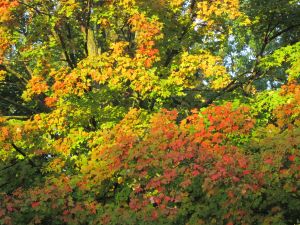
(NOTE: There is an entry on Maples at the Nature's Restaurant Online site. Maple Drink, Tea, Coffee & Syrup (Silver Maple, Red Maple, Sugar Maple & Manitoba Maple Sap).)
For a How-To article on making Maple syrup, go to the Articles section pages: Part 1 - Getting the Sap and Part 2 - Processing the Sap.
When most people think about tapping a maple tree, they think of tapping a Sugar Maple and making maple syrup out of it. I've made the drink, tea, coffee and syrup out of the Silver Maple, Red Maple, Sugar Maple and Manitoba Maple Sap, and while each has its own flavor, all are good. The nice thing about Manitoba Maples is they are very common in cities, growing where they are unwanted, and even fairly small ones will work (15 cm or 6 inches diameter truck at chest height is as small as you should use). Silver maples and sugar maples should be at least 20 cm (8 inches) in diameter, and only put in one tap per tree. Once the buds start to open, it is too late for harvesting the sap, so you will have to be able to identify them without leaves. If you don't feel confident doing that, identify the trees the year before while the leaves are still on. There are other types of Maple trees on the East side of North America that are said can be used for the sap including the invasive Norway Maple. But the Silver, Red, Sugar and Manitoba Maples are the only four I have used, so they are the only ones I can recommend. The instructions for how to use the sap is after the descriptions of the four types of Maple I use. DO NOT use sap from the Striped Maple (Acer pensylvanicum), in fact, don't get the sap on the skin as it can cause a Poison Ivy type reaction, though milder.
Growing Maples is very simple. Plant a key, transplant a little tree, or buy one and plant. Not even much to say on the subject. They tolerate shade better than most trees, but will grow faster in more light. Can handle a wide range of soil types and acidity. If where you want them is wet for a time in the spring, go for the Silver or Red Maple. If transplanting, do it in the early spring or fall. Like most trees, if you have the soil loosed by digging around where it will go, and mixing in compost with the soil from the hole, and watering well after planting and not letting it dry out for the first year, you will have much better luck with it taking and it will grow faster. Like many tree based edibles, the bad news is it will take many years after planting before you can tap the sap.
Silver Maple (Acer saccharinum). Known also as the Creek Maple, Silverleaf Maple, Soft Maple, Water Maple, Swamp Maple and White Maple. This is the one I like best for the taste. Sugar Maple is sweeter, Manitoba Maple is very good too, but this one has a taste that to me, is the best. It does require more boiling down than the Sugar Maple sap, but I don't mind. It has about half the sugar content of the Sugar Maple, so you will need to boil off half to get it to the Sugar Maple sugar level. I find it perfect to boil off half for using with the tea and coffee recipes listed below. By the way, the taste of this one is catching on in Europe, and the syrup made from the Silver Maple sap is the most expensive kind in Europe now.
Description:
- USDA Plant Hardiness Zone: 3-8 (More information on hardiness zones).
- Soil pH: 3.7-7.3
- Plant Size: Up to 30 meters (100 feet) tall, usually less, but can even be a bit more
- Duration: Can live well over 100 years
- Leaf Shape: Palmate. Typical Maple Leaf shape with very deep cut lobes. 5 main lobes, with smaller lobe on each of the 5 lobes.
- Leaf Phyllotaxis (Arrangement) on branch: Opposite
- Leaf Size: 8–16 cm (3 to 6 inches) long and 6–12 cm (2 1/3 to 4 3/4 inches) wide
- Leaf Margin: Serrated (saw toothed edge)
- Leaf Notes: Underside of leaf is a white-silver. Leaf underside is downy.
- Flowers: Dense clusters of red flowers in early spring before the leaves open
- Fruit: Pair of keys (Samaras) produced in late spring. Largest keys of any Maple trees.
- Bark: Grey and shaggy when old, silver-grey and smooth when young.
- Habitat: Damp places, wet areas, along streams and rivers. Also planted in cities along roads and in parks. A very common Maple tree.
Web Resources:
- Pictures on the web here (Google images) and here (Bing images).
- Interactive USDA distribution map and plant profile here.
- The Biota of North America Program (BONAP) distribution map here. BONAP map color key here.

Silver Maple (Acer saccharinum) range. Distribution map courtesy of U. S. Department of Agriculture (USDA Natural Resources Service) and used in accordance with their policies.
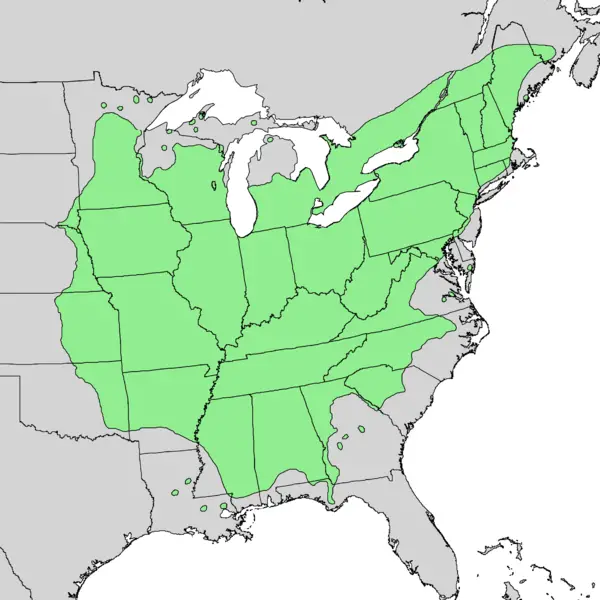
Silver Maple (Acer saccharinum) range. Distribution map courtesy of the USGS Geosciences and Environmental Change Science Center, originally from "Atlas of United States Trees" by Elbert L. Little, Jr. .

Silver Maple leaves. Notice how deep the lobes are on each leaf.
Red Maple (Acer rubrum).
Description:
- USDA Plant Hardiness Zone: 3-9 (More information on hardiness zones).
- Soil pH: 3.0-7.3
- Plant Size: Up to 30 meters (100 feet) tall, usually less, but can even be a bit more
- Duration: Can live well over 100 years
- Leaf Shape: Highly variable. Palmate. Maple leaf shape with 3-5 lobes
- Leaf Phyllotaxis (Arrangement) on branch: Opposite
- Leaf Size: About 10 cm (4 inches) long
- Leaf Margin: Serrated (saw toothed edge)
- Leaf Notes: Underside of leaf is lighter in color than the upper side.
- Flowers: Dense clusters of red flowers in early spring before the leaves open
- Fruit: Pair of keys (Samaras) produced in late spring.
- Bark: Twigs are reddish with lenticels (checking). Grey-brown with broken into plates when mature.
- Habitat: Almost any conditions within its range. Very common Maple tree. Can handle damper areas.
Web Resources:
- Pictures on the web here (Google images) and here (Bing images).
- Interactive USDA distribution map and plant profile here.
- The Biota of North America Program (BONAP) distribution map here. BONAP map color key here.
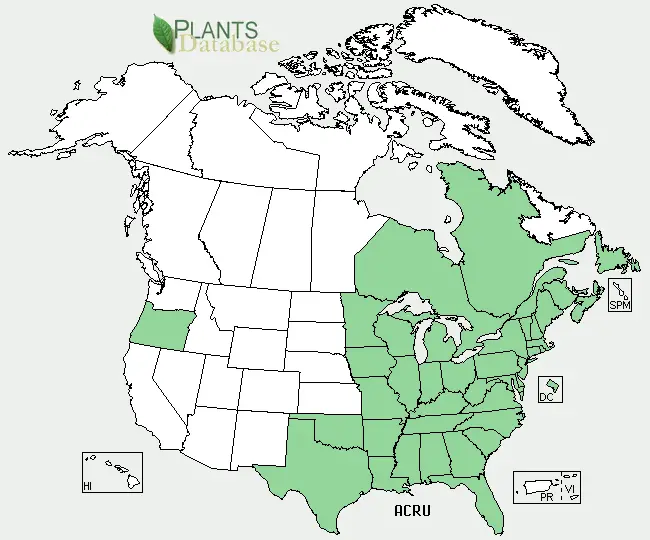
Red Maple (Acer rubrum) range. Distribution map courtesy of U. S. Department of Agriculture (USDA Natural Resources Service) and used in accordance with their policies.

Red Maple (Acer rubrum) range. Distribution map courtesy of the USGS Geosciences and Environmental Change Science Center, originally from "Atlas of United States Trees" by Elbert L. Little, Jr. .
Sugar Maple (Acer saccharum). Known also as the Rock Maple. There is also the Black Maple (Acer nigrum or Acer saccharum subsp. nigrum). Depending on the taxonomist it can be regarded as a separate species of from the Sugar Maple, or a subspecies. They can form hybrids making it nearly impossible to tell which one you have. Basically, the true Sugar Maple has five lobed leaves, while the Black Maple has three lobed leaves and darker (nearly black, hence the name) bark with vertical furrows. For the purpose of the sap, I consider it the same as the true Sugar Maple as do commercial sugar maple producers.
Description:
- USDA Plant Hardiness Zone: 3-8 (More information on hardiness zones).
- Soil pH: 3.7-7.3 (ideal is 5.5-7.3)
- Plant Size: Up to 35 meters (115 feet) tall, though can be more on occasion
- Duration: Can live well over 200 years
- Leaf Shape: Palmate. This is the classic Maple leaf shape. The true Sugar Maple has 5 lobes, while the Black Maple has 3 lobes.
- Leaf Phyllotaxis (Arrangement) on branch: Opposite
- Leaf Size: Up to 20 cm (8 inches) long and wide
- Leaf Margin: This is a tough one, you could look at it as either Entire (smooth edged) with small pointed lobes on the main lobes or with very large, course Serrated (saw toothed edge) margin.
- Leaf Notes: Turns bright orange and red colors in the fall.
- Flowers: Clusters of long stemmed yellow-green flowers
- Fruit: Small pairs of keys (Samaras) in the fall.
- Bark: Light to dark grey to a silvery-grey. Broken into shaggy vertical sections on mature trunks. The Black Maple has a nearly black, deeply furrowed bark when mature, and dark grey and smooth bark when young.
- Habitat: Forests of Eastern North America. Very shade tolerant tree. Can adapt to a huge variety of conditions and soil types.
Web Resources:
- Pictures on the web here (Google images) and here (Bing images).
- Interactive USDA distribution map and plant profile here.
- The Biota of North America Program (BONAP) distribution map here. BONAP map color key here.

Sugar Maple (Acer saccharum) range. Distribution map courtesy of U. S. Department of Agriculture (USDA Natural Resources Service) and used in accordance with their policies.
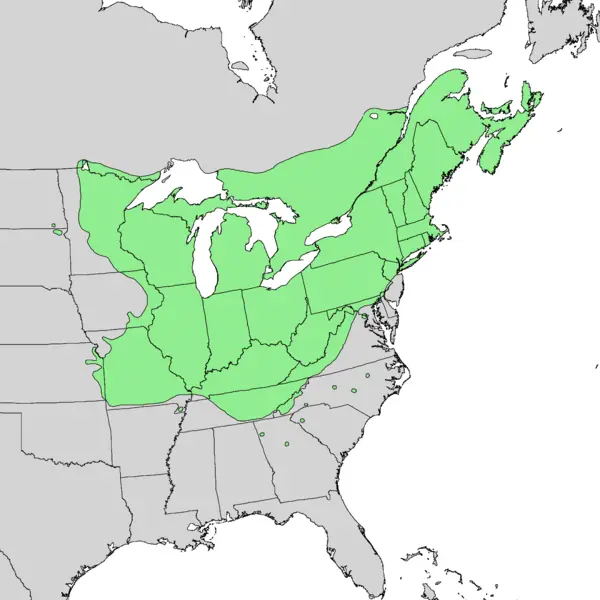
Sugar Maple (Acer saccharum) range. Distribution map courtesy of the USGS Geosciences and Environmental Change Science Center, originally from "Atlas of United States Trees" by Elbert L. Little, Jr. .
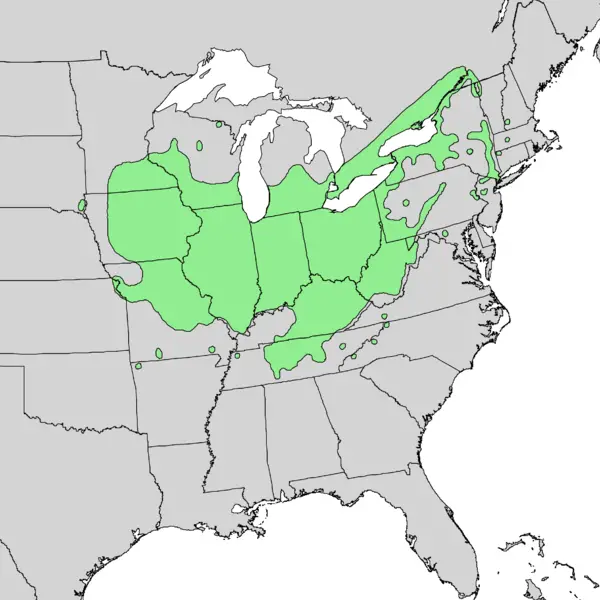
Black Maple (Acer nigrum or Acer saccharum subsp. nigrum) range. Distribution map courtesy of the USGS Geosciences and Environmental Change Science Center, originally from "Atlas of United States Trees" by Elbert L. Little, Jr. .
Manitoba Maple (Acer negundo) or Box Elder. This one has many other common names. Be very aware that baby Manitoba Maple with the three leaflet compound leaves can look like the ground version of Poison Ivy. This is dangerous, because if you find a mature Manitoba Maple, there could be Poison Ivy around it that you think are just baby Manitoba Maples. Know before touching or transplanting.
Description:
- USDA Plant Hardiness Zone: 2-8 (More information on hardiness zones).
- Soil pH: 6.5-7.5
- Plant Size: Generally up to 25 meters (82 feet) tall
- Duration: Relatively short lived for a Maple tree - generally under 100 years.
- Leaf Shape: Odd Pinnate compound leaves with 3-7 leaflets than can be 3 lobed or not lobed.
- Leaf Phyllotaxis (Arrangement) on branch: Opposite
- Leaf Size: Leaflets are up to 10 cm (4 inches) long
- Leaf Margin: Serrated (saw toothed edge)
- Leaf Notes: Highly variable leaflet shape - see included photo below
- Flowers: Light pink to yellow-green very small drooping clusters of flowers on long stems in spring
- Fruit: Pairs of keys (Samaras) that can persist on tree into the next spring.
- Bark: Grey to brown with ridges.
- Habitat: Very common city tree along fence lines, in flood plains, disturbed lands. In rural areas, tends to be found most commonly in flood plains and low lying areas and along rivers and creeks.
Web Resources:
- Pictures on the web here (Google images) and here (Bing images).
- Interactive USDA distribution map and plant profile here.
- The Biota of North America Program (BONAP) distribution map here. BONAP map color key here.
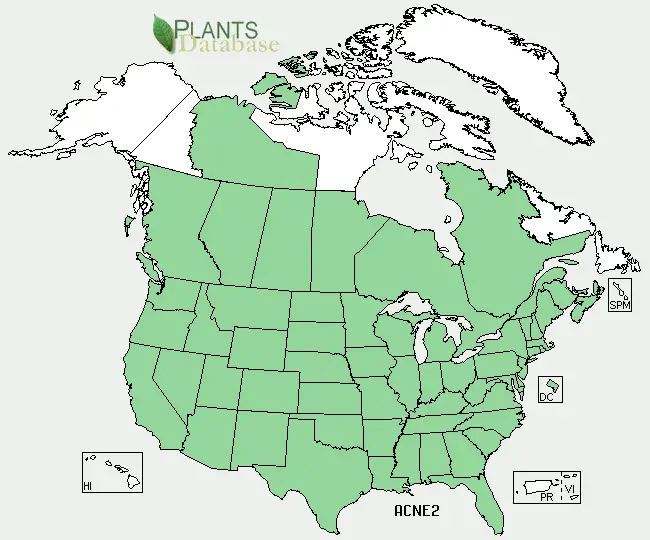
Manitoba Maple Acer negundo range. Distribution map courtesy of U. S. Department of Agriculture (USDA Natural Resources Service) and used in accordance with their policies.

Manitoba Maple Acer negundo range. They are also present in Central Ontario along the York River, very common with many old specimens along the Thames River in London, Ontario. I have seen them in other places in Southern Ontario, where this map indicates they are not present. Distribution map courtesy of the USGS Geosciences and Environmental Change Science Center, originally from "Atlas of United States Trees" by Elbert L. Little, Jr. .
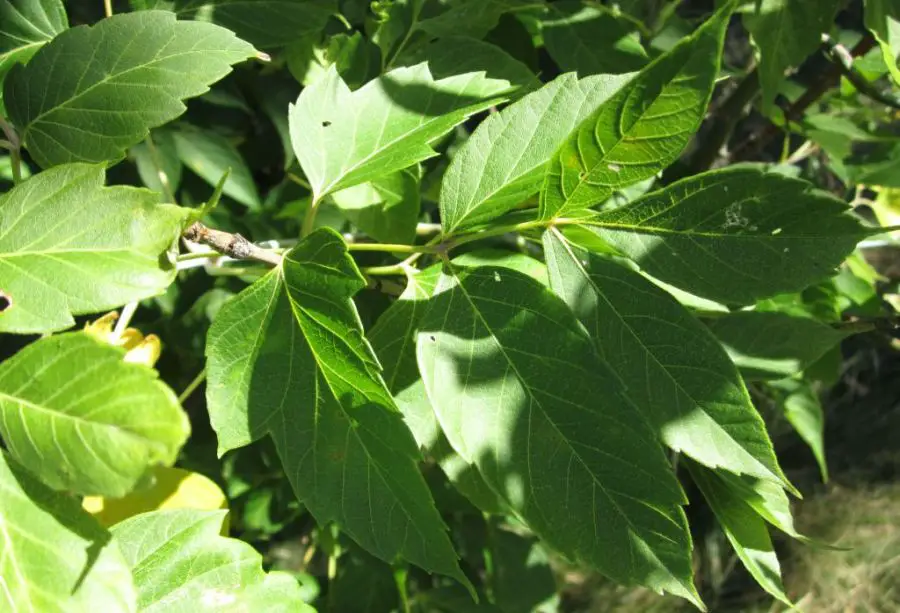
Manitoba Maple Acer negundo. Leaves. Notice how this leaflet has 7 leaves on a single stem coming from the branch. The lowest 2 opposite leaves look like 2 small leaves and one bigger center one have merged. The middle 2 opposite leaves are oval shaped with sawtooth edges. The top leaf is fully divided into 3 smaller leaves. This is normal for a Manitoba Maple, although it might only have 3 leaflets per leaf or 9 or more.
What you need for all uses:
- A Maple tree over 8 inches diameter (Manitoba Maples smaller)
- A Sap Tap
- A bucket
- A lid for the bucket
You can usually get the supplies at your local farm hardware store. Where I live in Southwestern Ontario, there is a chain of stores called TSC where they have all that is needed for under $10.00 to tap a single tree in the spring.
What You Do
As the temperature in March rises above freezing in the day and slips below freezing in the evening and before the green comes out in the tree, drill the hole in the tree on a south facing side at three to four feet above the ground (usually 7/16 inch bit and to about one and a quarter inch deep, but follow what the instructions say – if you don't have a 7/16 inch bit, you can use a 1/2 inch bit, but try to not let it wander). Lightly hammer in the tap and hang the bucket and lid.

This is all you need to get started. I would suggest only buying one of each the first year. If you get a good tap, you will have all the sap you need except if you want to make quantities of syrup.
Maple Drink:
When the sap is fresh from the tree, just filter it (a fine strainer or coffee filter works just fine) and drink. That's it. No other work. It will keep in the fridge for a couple of days.
Maple Tea:
I bought eight of everything one year to make syrup and ended up with so much sap I didn’t know what do with it all. I came up with the idea of this tea just to help use it up. I fell in love with the tea right away. I then added classic East Indian tea ingredients and was blown away! Try both the simple and Indian version. I usually make both each day the sap is running and several days after. It is only good for a couple of days in the fridge – it will go off quite quickly. If you want it to last longer, you have to freeze it.
When you get a descent amount of sap for tea, strain it with a plastic or metal coffee filter (paper filters work but are slower ) or just use a very fine metal tea sieve. Bring to a boil and simmer for at least half an hour or to taste. The longer you boil it the sweeter it gets. With Manitoba and Silver Maple, boil off half the amount you started with. Pour into mug and drink. I drank eight cups once and would have drank more if it were not for the uncomfortable sensation in my stomach from the quantity. I recovered to drink more before the sun set. Nobody I've served this tea to had any other reaction than, “this is unbelievably good”.
If you like milk in your tea, add it as you would for regular tea.
You can use this simmering sap to make regular tea. Put a teabag in a cup, pour over simmering sap, steep to your usual strength, and take the teabag out and drink as you normally would. The only problem is, when you have no more sap, you'll find it hard to get used to tea made with water again.
East Indian Version
To 2 cups of the sap add:
- 1 or 2 cloves
- 1 to 2 inches of sliced ginger
- 1 or 2 whole green cardamom pods
- 1 inch of vanilla bean sliced down the center
- 1 to 2 inches of cinnamon bark (unground cinnamon)
Boil it just as in the previous recipe and strain before serving. Add milk after serving. It is necessary I find with this version.
Maple Coffee:
You can take some of this simmering sap and make coffee with it. One tablespoon of dark roast to a mug of sap, let sit, filter off the grounds and drink. Fantastic coffee.
Maple Syrup
To make syrup, just keep simmering the sap down until you notice it starts to turn a little thicker. Be careful, as when hot it seems thinner that you would expect the final product to be. When it cools it will thicken. Better to be safe by having it a touch to thin than to burn it and waste your effort. Keep a close eye on it in the later stages because the change from a thin liquid to a syrup happens fairly suddenly. After it has been in jars for a couple of days you will see a white layer of minerals on the bottom. You can pour off into another jar leaving this behind or just ignore it. It's mainly calcium.
Your biggest stainless steel pot with a thick bottom is your best bet. Cheap, thin bottomed stainless steel pots will burn the syrup fast.
Web Resources:
For more information on making Maple syrup.
Search Wild Foods Home Garden & Nature's Restaurant Websites:
Share:
Why does this site have ads?
Originally the content in this site was a book that was sold through Amazon worldwide. However, I wanted the information to available to everyone free of charge, so I made this website. The ads on the site help cover the cost of maintaining the site and keeping it available.
Google + profile
